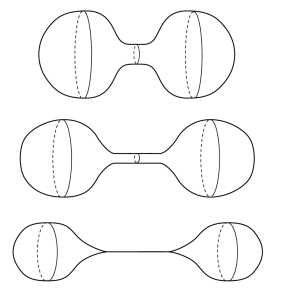As part of our series of research articles focusing on the rigour and intricacies of mathematics and its problems, Oxford Mathematician Andrew Dancer discusses his work on Ricci Flow.
"A sphere and an ellipsoid (rugby ball) are the same topologically, in that each can be continuously deformed into the other without tearing, but obviously they are not the same geometrically. We can see that the sphere is in some sense uniformly curved, while the curvature of the ellipsoid varies as we move around the surface.
The mathematical gadget that encodes information about curvature, lengths, angles, volumes etc. is called a metric. This concept in fact makes sense not just for surfaces but in higher dimensions as well. The curvature is now not a single function but an object called the Riemann curvature tensor.
A fundamental question in geometry is whether a given manifold has a best or nicest metric. One popular candidate is the notion of an Einstein metric. The equations expressing the Einstein condition are a complicated nonlinear system of partial differential equations, and questions about existence and uniqueness of Einstein metrics in dimensions above three are still not well understood in general.
One strategy to study the existence of Einstein metrics is via the Ricci flow. This is a nonlinear version of heat flow, whose fixed points correspond to Einstein metrics, rather as fixed points of heat flow correspond to harmonic functions (solutions of Laplace's equation). In good situations the Ricci flow may converge to an Einstein metric, but it is also possible for singularities to develop, arising from the nonlinear nature of the flow. I am particularly interested in so-called soliton solutions of the heat flow, corresponding to metrics that evolve just by rescaling and coordinate changes under the flow. These give a natural generalisation of the Einstein condition, and are also very important in understanding singularities of the flow via a rescaling of
variables.
In collaboration with Mckenzie Wang of McMaster University in Canada, I have produced new examples of solitons by assuming the existence of a large enough symmetry group to reduce the PDEs to ordinary differential equations. With my student Alejandro Betancourt de la Parra, we have even found some cases where the soliton equations may be solved explicitly, due to unexpected integrability structures in certain dimensions."
For fuller explanations of Andrew's work please click on the links below:
On Ricci solitons of cohomogeneity one
Some New Examples of Non-Kähler Ricci Solitons
A Hamiltonian approach to the cohomogeneity one Ricci soliton equations
Image above courtesy of Syafiq Johar


